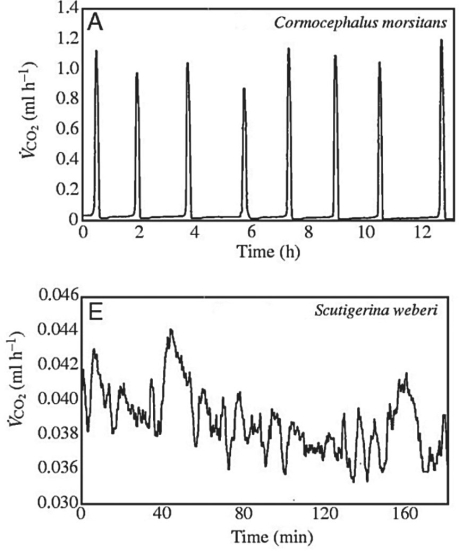Multiple Choice
Use the following information when answering the corresponding questions) .
Many terrestrial arthropods exchange gases with their environments by using tracheae, tubes that lead from openings called spiracles) in the animal's exoskeleton or cuticle directly to the animal's tissues. Some arthropods can control whether their spir opened or closed; opening the spiracles allows the carbon dioxide produced in the tissues to travel down the tracheae and be released outside the animal. Klok et al. measured the carbon dioxide emitted over time represented by VCO2) by several species of centipedes. Figure 31.2 presents graphs of their results for two species, Cormocephalus morsitans and Scutigerina weberi. C. J. Klok, R. D. Mercer, and S. L. Chown. 2002. Discontinuous gas- exchange in centipedes and its convergent evolution in tracheated arthropods.  Figure 31.2
Figure 31.2
-How would a terrestrial centipede most likely benefit from the ability to close its spiracles?
A) The centipede would not benefit at all.
B) Closing spiracles would allow the centipede to move more quickly.
C) Closing spiracles would allow the centipede to stay warmer.
D) Closing spiracles would allow more oxygen from the environment to reach the centipede's tissues.
E) Closing spiracles would allow the centipede to retain more moisture in its tissues.
Correct Answer:

Verified
Correct Answer:
Verified
Q7: What do all the Lophotrochozoa phyla discussed
Q8: Nematodes and arthropods both<br>A) are suspension feeders.<br>B)
Q9: All arthropods<br>1) undergo complete metamorphosis.<br>2) have jointed
Q10: Upon close inspection of movement in annelids
Q11: What would be the best anatomical feature
Q13: The major evolutionary split of protostome animals
Q14: You find a multilegged animal in your
Q15: Which of the following do Nematoda and
Q16: <img src="https://d2lvgg3v3hfg70.cloudfront.net/TB6548/.jpg" alt=" Figure 31.1 -Refer
Q17: Which of the following attributes is not